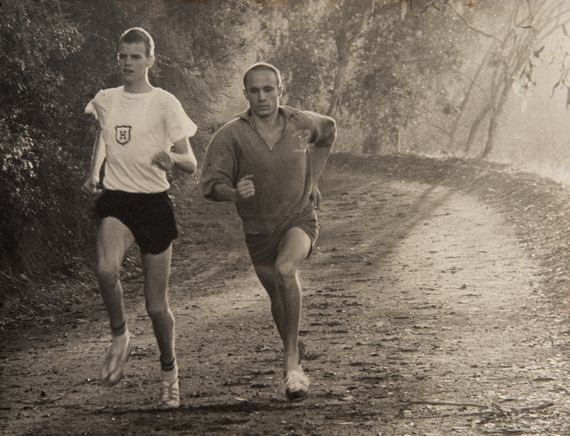The author and teammate Mike Riebs, Santa Monica Mountains, 1961
Even the youthful may faint and grow weary,
even the fittest may stumble and fall,
but those who wait for the Lord shall renew their strength,
they shall mount up with wings like eagles,
they shall run and not be weary,
they shall walk and never faint. (Isaiah 40:30-31)
The perpetual contest between weariness and perseverance is familiar to every athlete, and every saint. You're going to get tired. You're going to get discouraged. You may faint and fall. But keep your eyes on the prize, hold on. On good days and bad, you've got to put in the work, lay aside every weight, surrender to a power beyond your solitary will, and stay in the flow.
Over the coming weeks, we will see Olympic athletes do extraordinary things with their bodies, minds and hearts. Some of us will be inspired by their example to get in shape and pursue a goal, to test the limits of our own embodied existence. Others will remain passive spectators, admiring the exceptional gifts of the Olympians with no illusions of doing likewise.
When I was a teenager, I wanted to be a great pole vaulter. I loved the sudden ascent from the runway, feet swinging into the sky, the joyful clearance over the bar, the happy fall back to earth. I aspired to emulate world record holder Bob Gutowski, and for two years in college competed under his coach, Payton Jordan. But I lacked the necessary speed and strength to master the event, and gave it up before my 20th birthday.
I had thought I was a pole vaulter, but would come to discover that I was actually a distance runner. I had run cross-country and the mile in high school, thinking it would be good conditioning for my "real" event. But it wasn't until my thirties that I finally embraced running as my athletic vocation.
I love the details of training, measuring daily progress as I increase the load and intensity of my runs. I love the mental challenge of racing, the ceaseless negotiation between desire and pain. I love the sense of aliveness that can follow the most exhausting workouts. But most of all I love the poetry of bodily motion, the primal elation of loping unhindered through space, dancing with earth and sky.
Sometimes you get into "the zone" and feel you could run forever. But that feeling is the fruit of weeks and months of training. St. Paul, clearly a track fan, knew the amount of work required to get into shape and win the race. "Every athlete concentrates completely on training," he wrote. "I punish my body and bring it under control." (I Cor. 9:25, 27). In other words, no pain, no gain.
That doesn't mean not to back off and be gentle when your body needs rest and recovery. My first two marathon attempts ended with training injuries from increasing my mileage before my body was ready. Don't forget to keep your Sabbath days!
On the tough days, the questions multiply. Why am I putting myself through this? Can my body take it? What's the point?
When the questions pounce, you need the will to embrace and accept the pain. Great runners learn to let go, to trust that the pain is bearable, to hold nothing back, to surrender to that elusive, transcendent thing that takes over when we reach our limit.
Roger Bannister, who collapsed after he broke the 4-minute mile barrier in 1954, said that "the man who can drive himself further once the effort gets painful is the man who will win."
Another great miler, 1960 Olympic 1500 meter champion Herb Elliott, received the same lesson from his coach, Percy Cerutty, who thought running uphill on sand dunes until you crumbled was an ideal form of training. Cerutty told Elliott, who never lost a race, that "great runners must learn to die."
Seen in this way, athletics is not just a metaphor for spirituality, but a plunge into the deepest sources of the self. "Learning to die" is the operation of a mysticism where subjectivity is transcended and absorbed into a greater whole. The athletes who "disappear" into the Zone or the Flow for a few fleeting moments may struggle to put language to it, but they know something extraordinary has happened that was not of their own making.
What we do with our bodies manifests and expresses inner states, the sacred ground of our being. But bodily practices can also induce inner states. How we move, how we sit, how we breathe, can all make a difference in our spiritual life. Inner and outer are intertwined and interactive. We pray in, with, through our bodies.
Running is a prayer practice for me. I was never an elite runner. But the body I run with is my body, inscribed with the history of my own heart and, to quote Chariots of Fire, "when I run, I can feel God's pleasure."
While training for the Boston Marathon at age forty, I took a run down a grassy median in Santa Monica, a popular running spot. I saw Johnny Gray, American record holder for 800 meters and four-time-Olympian, stepping onto the path just ahead of me, and for the next two miles I tried to keep pace with him, just to see what it felt like. He appeared to be jogging, with an effortless, graceful stride. I, on the other hand, was working pretty hard to keep up. But for that little while, following in Gray's footsteps, I felt my own best runner wanting to emerge.
An old Anglican prayer asks God to "give us grace...to follow daily in the blessed steps of [Jesus'] most holy life." What more can we ask of our stories, but to follow daily the blessed steps as best we can, bringing the flawed and glorious dispositions of our embodied selves into the living of our days?
